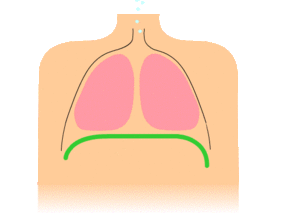Breathing Exercises
Original Editor - Lucinda hampton
Top Contributors - Lucinda hampton, Prashna Singh, Stella Constantinides, Robin Amel, Kim Jackson, Samuel Winter and Rishika Babburu
Introduction[edit | edit source]
Breathing exercises are a form of exercise that can be used for a variety of reasons.eg: to enhance the respiratory system by improving ventilation, strengthening respiratory muscles, and make breathing more efficient; for stress reduction and relaxation; in yoga to improve blood circulation, calm nerves and draw in vital substances[1][2].
Improper breathing can upset the oxygen and carbon dioxide exchange and contribute to anxiety, panic attacks, fatigue, and other physical and emotional disturbances.[3]
Diaphragmatic Breathing[edit | edit source]
Diaphragmatic breathing is a type of breathing exercise that helps strengthen the diaphragm, an important muscle that helps with breathing, as it represents 80% of breathing. This breathing exercise is also sometimes called belly breathing or abdominal breathing[4].
Pursed Lips Breathing[edit | edit source]
Pursed-lip breathing is a breathing technique that consists of exhaling through tightly pressed (pursed) lips and inhaling through the nose with the mouth closed. It is a simple breathing technique that helps with making deep breaths slower and more intentional. This technique has been found to benefit people who have anxiety associated lung conditions eg emphysema and chronic obstructive pulmonary disease (COPD)[5]
Box Breathing[edit | edit source]
Box breathing can be helpful with relaxation. Box breathing is a breathing exercise to assist patients with stress management and can be implemented before, during, and/or after stressful experiences. Box breathing involves visualizing a journey around the four sides of a square, pausing while travelling horizontally and breathing in while travelling up the square and out while travelling down it. This exercise can be implemented in many environments, not requiring a calm environment to be effective.
- Step One: Breathe in through the nose for a count of 4.
- Step Two: Hold breath for a count of 4.
- Step Three: Breath out for a count of 4.
- Step Four: Hold breath for a count of 4.
- Repeat[6]
Mindful Breathing[edit | edit source]
Mindfulness meditation involves focusing on your breathing and bringing your attention to the present without allowing your mind to drift off to the past or future.
Choose a calming focus, including a sound ("om"), positive word ("peace"), or phrase ("breathe in calm, breathe out tension") to repeat silently as you inhale or exhale.
Let go and relax. When you notice your mind has drifted, take a deep breath and gently return your attention to the present.
Resources[edit | edit source]
- bulleted list
- x
or
- numbered list
- x
References[edit | edit source]
- ↑ Medical dictionary Breathing exercises Available: https://medical-dictionary.thefreedictionary.com/breathing+exercise (accessed 11.3.2022)
- ↑ Lung Org Breathing exercises Available:https://www.lung.org/lung-health-diseases/wellness/breathing-exercises (accessed 11.3.2022)
- ↑ Paulus MP. The breathing conundrum—interoceptive sensitivity and anxiety. Depression and anxiety. 2013 Apr;30(4):315-20.Available: https://onlinelibrary.wiley.com/doi/10.1002/da.22076(accessed 3.11.2022)
- ↑ Physiopedia Diaphragmatic breathing.
- ↑ Very well health 8 Deep Breathing Exercises for Anxiety Available: https://www.verywellmind.com/abdominal-breathing-2584115#citation-11 (accessed 11.3.2022)
- ↑ Norelli SK, Long A, Krepps JM. Relaxation Techniques.[Updated 2021 Jul 26]. StatPearls [Internet]. Treasure Island (FL): StatPearls Publishing. 2021. Available;https://www.ncbi.nlm.nih.gov/books/NBK513238/ (accessed 11.3.2022)








